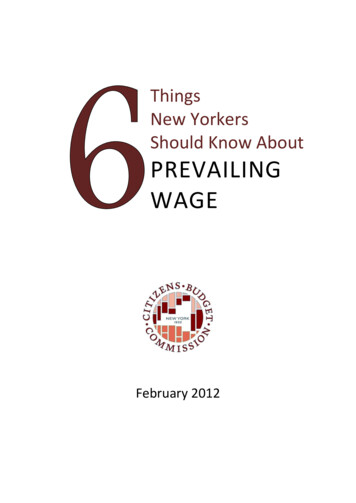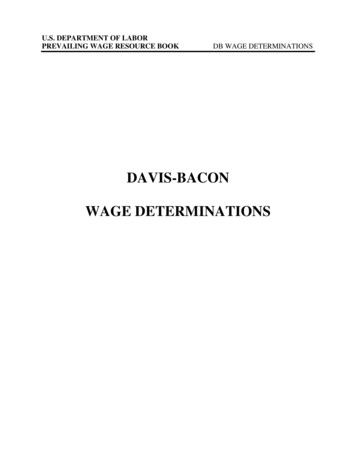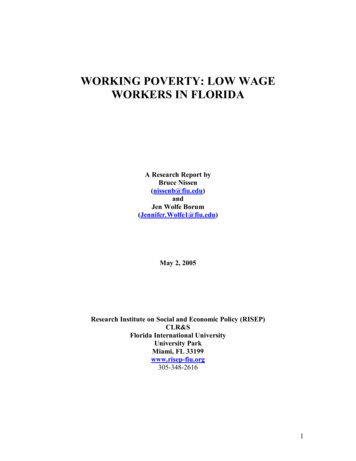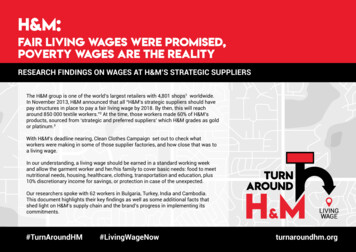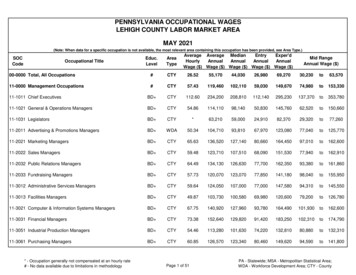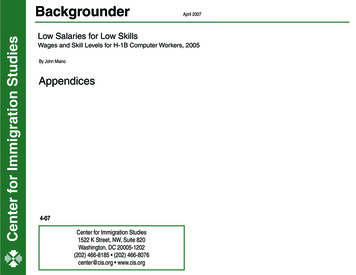
Transcription
Presenting a live 90-minute webinar with interactive Q&AWage & Hour Collective and Class Actions:Asserting and Challenging Affirmative DefensesLeveraging Good Faith, Doctrine of Avoidable Consequences, and Other DefensesTUESDAY, MARCH 31, 20201pm Eastern 12pm Central 11am Mountain 10am PacificToday’s faculty features:Melissa Lardo Stewart, Partner, Outten & Golden, New YorkNoel P. Tripp, Principal, Jackson Lewis, Melville, N.Y.The audio portion of the conference may be accessed via the telephone or by using your computer'sspeakers. Please refer to the instructions emailed to registrants for additional information. If youhave any questions, please contact Customer Service at 1-800-926-7926 ext. 1.
Tips for Optimal QualityFOR LIVE EVENT ONLYSound QualityIf you are listening via your computer speakers, please note that the qualityof your sound will vary depending on the speed and quality of your internetconnection.If the sound quality is not satisfactory, you may listen via the phone: dial1-877-447-0294 and enter your Conference ID and PIN when prompted.Otherwise, please send us a chat or e-mail sound@straffordpub.com immediatelyso we can address the problem.If you dialed in and have any difficulties during the call, press *0 for assistance.Viewing QualityTo maximize your screen, press the ‘Full Screen’ symbol located on the bottomright of the slides. To exit full screen, press the Esc button.
Continuing Education CreditsFOR LIVE EVENT ONLYIn order for us to process your continuing education credit, you must confirm yourparticipation in this webinar by completing and submitting the AttendanceAffirmation/Evaluation after the webinar.A link to the Attendance Affirmation/Evaluation will be in the thank you emailthat you will receive immediately following the program.For additional information about continuing education, call us at 1-800-926-7926ext. 2.
Program MaterialsFOR LIVE EVENT ONLYIf you have not printed the conference materials for this program, pleasecomplete the following steps: Click on the link to the PDF of the slides for today’s program, which is locatedto the right of the slides, just above the Q&A box. The PDF will open a separate tab/window. Print the slides by clicking on theprinter icon.
Wage & Hour Collective and ClassActions: Asserting and ChallengingAffirmative DefensesLeveraging Good Faith, Doctrine of AvoidableConsequences and Other Defenses
AgendaWe will discuss:1. FLSA’s good faith defenses2. Similar state law defenses3. Other defenses commonly invoked with respect to claimsregarding hours worked.We will not discuss: All of the wage-hour defenses under the sun, including the exemptions and exclusions set forth in 29 U.S.C. §§ 203, 207 and 213.Many of the exemptions are affirmative defenses. But see Walton v. United Consumers Club, 786 F.2d 303 (7th Cir. 1986)(payment 29 U.S.C. § 207(i) is a “method of complying with the Act”).66
Affirmative Defenses: FLSA Defenses#1:The FLSA’s Good Faith Defenses77
FLSA Good Faith: Two Defenses“Good faith” defense can be an absolute defense (29 USC § 259) and a defense toliquidated damages (29 USC § 260).Complete Defense (§ 259)– No liability for failure to pay minimum wages or overtime compensation if proven that theact or omission complained of was in good faith in conformity with and in reliance on anywritten administrative regulation, order, ruling, approval, or interpretation of the DOL.Congressional Purpose of Defense FLSA not intended to provide “windfall payments, including liquidated damages, of sumsfor activities performed by them without any expectation of reward beyond that includedin their agreed rates of pay.”88
Affirmative Defenses: FLSA DefensesRequirements for Complete Defense:(1) action taken in reliance on written admin. reg., order, ruling,approval, or interpretation by U.S. DOL, or any admin. practiceor enforcement policy;(2) in conformity with that ruling; and(3) in good faith.Objective test of employer's good faith is whether employer acted as“reasonably prudent man would have acted under similarcircumstances.”Subjective test is whether employer “had honesty of intention and noknowledge of circumstances which ought to put him upon inquiry.”929 C.F.R. § 790.15.9
Complete Defense (Section 259) – Narrowly Construed (Identical Facts) Facts must be close to identical between your case and the scenario that led to theorder/ruling/interpretation that is relied upon.Cole v. Farm Fresh Poultry, Inc., 824 F.2d 923, 927 (11th Cir. Ala. 1987) “None of the examples are closely analogous to the situation of the employeesworking on the eviscerating line at Farm Fresh. Thus while the Bulletin itselfprovides some examples pertinent to particular situations, no specific guidance isprovided for the situation at bar, and the Bulletin itself clearly recognizes that theprovisions therein provide only general guidelines to be applied in light of all theparticular circumstances of each case. Thus the Bulletin itself does not claim toestablish a particular rule upon which an employer may rely in order to determinewhat length and type of waiting period is compensable time worked under theparticular facts of this case. Thus it was in fact simply impossible for Farm Fresh torely on it.”10
Complete Defense (Section 259) – Narrowly Construed (Identical Facts)Swigart v. Fifth Third Bank, 870 F. Supp. 2d 500,511 (S.D. Ohio 2012) Reliance on opinion letter regardingemployees who had the same job title did notsuffice, where employer did not conduct asufficient investigation to determine whetheractual job duties were “the same job duties asthe mortgage loan officers described in the2006 Opinion Letter.”11
Complete Defense (Section 259) – Narrowly Construed (Source of Ruling) Ruling relied upon must be in writing and issued by the Administrator of the Wageand Hour Division of the Department of Labor. Reliance on rulings from lower levelofficer or employee of the agency (e.g. Regional Directors) likely will not satisfy theemployer’s burden. See Hodgson v. Square D Co., 459 F.2d 805, 810 (6th Cir. Ky.1972).– “§ 259(a) requires that the writing must be ‘of the agency of the United Statesspecified in subsection (b) of this section,’ and § 259(b) specifically provides, interalia, that the agency referred to in subsection (a) shall be ‘the Administrator ofthe Wage and Hour Division of the Department of Labor.’ The Company arguesthat ‘Administrator’ means the organization rather than the individual, butunfortunately the regulations and the case law do not support the Company'sposition.”12
Complete Defense (Section 259) – Narrowly Construed (“in actualconformity with”)Employer must confirm that “its actions actually conformed with the letter” and that the“circumstances described in the opinion letter” match the employer's own “actualcircumstances.”Lewis v. Huntington Nat’l Bank, 838 F. Supp. 2d 703, 717–18 (S.D. Ohio 2012)Employer’s investigation did not include:(1)Any interviews with people in the job title; or(2)Any observational studies.13
Affirmative Defenses: FLSA DefensesDefense to Liquidated Damages (Section 260):(1)Subjective good faith, defined as honesty ofintention and no actual or constructive noticeof an FLSA violation; and(2)Employer's reasonable grounds to believethat its conduct complies with the Act.1414
Defense to Liquidated Damages (Section 260) “[I]f the employer shows to the satisfaction of the court that the act or omissiongiving rise to such action was in good faith and that he had reasonable grounds forbelieving that his act or omission was not a violation of the Fair Labor Standards Actof 1938, as amended, the court may, in its sound discretion, award no liquidateddamages . . . .” 29 U.S.C. § 260.– Employer must show that it acted in subjective good faith with objectivelyreasonable grounds for believing that its acts or omissions did not violate theFLSA. Barfield v. New York City Heath & Hospitals Corp., 537 F.3d 132 (2d Cir.2008).– Not enough to show the absence of bad faith. To prevail, the employer mustshow that it took “active steps to ascertain the dictates of the FLSA and thenact[ed] to comply with them.” Herman v. RSR Sec. Servs. Ltd., 172 F.3d 132, 142(2d Cir. 1999); Clark v. Saporito, No. 3:18-cv-00660, 2020 U.S. Dist. LEXIS 54608(M.D. Pa. Mar. 30, 2020)(to rely on previously-provided USDOL opinion letter,needed to relate to policy at issue).15
Defense to Liquidated Damages (Section 260): Who decides?– Generally a determination for judge, not jury. Jury’s finding of willfulness constrains the court’s discretion to find good faith.Black v. SettlePou, P.C., 732 F.3d 492, 501 (5th Cir. 2013). But, a jury finding of no willfulness does not preclude a finding that theemployer did not act in good faith16
Defense to Liquidated Damages (Section 260): What Constitutes GoodFaith?Some examples include (non-exhaustive):– Reliance on advice of counsel. See e.g., Perez v. Mountaire Farms, 650 F.3d 350,375-76 (4th Cir. 2011).– Thorough review of pay records and practices. See e.g., Barfield v. New York CityHeath & Hospitals Corp., 537 F.3d 132 (2d Cir. 2008).– Reliance on advice of internal personnel experts (even if that advice proves incorrect).See e.g., Cross v. Arkansas Forestry Comm'n, 938 F.2d 912 (8th Cir. 1991).– Contacting DOL and/or relying on guidance from DOL.17
Defense to Liquidated Damages (Section 260): What Might Not Suffice toShow Good Faith?Some examples include (non-exhaustive):Scalia v. Employer Solution Staffing Group, LLC, 951 F.3d 1097 (9th Cir.2020)– Reliance on instructions from another entity (co-joint employer)– Lack of manager-level employee knowledge of the issueMartin v. Indiana Mich. Power Co., 381 F.3d 574, 584–85 (6th Cir. 2004)– Failure to investigate actual duties– Constructive knowledge of non-exempt duties (in the job description)– Employee complained about the violationBlotzer v. L-3 Commc’ns Corp., No. 11 Civ. 274, 2012 WL 6086931, at *15(D. Ariz. Dec. 6, 2012)– Reliance on industrywide practice18
Defense to Liquidated Damages (Section 260)Reliance on Advice of Counsel – Potential for Privilege Waiver When a defendant asserts the good faith defense, he “consequentlycannot ‘fairly both assert testimony that implicitly communicate[s] hisversion of the legal advice he received and simultaneously withholddisclosure of the legal advice actually received.’” Enea v. BloombergL.P., 2015 U.S. Dist. LEXIS 111901, *12 (S.D.N.Y. Aug. 20, 2015) (citingJohn Doe Co. v. United States, 350 F.3d 299, 304 (2d Cir. 2003)). The concept is that the attorney-client privilege cannot be usedsimultaneously as a sword and a shield.19
Defense to Liquidated Damages (Section 260):Scope of Privilege Waiver – Developing Area of the Law Foster v. City of New York, 2016 U.S. Dist. LEXIS 14594 (S.D.N.Y. Feb. 5, 2016):– Communications between counsel working on behalf of the City and any nonattorney employee of the agencies or the City are discoverable, as long as they arerelevant to advice provided to the agencies or the City regarding the agencies' FLSAcompliance.– However, internal communications between attorneys are not subject to discoverybecause the City’s “state of mind” could not have been influenced by informationof which it was unaware.– The Court rejected plaintiffs’ argument that all relevant communications related toFLSA compliance were subject to the privilege waiver (plaintiffs argued that the“implied waiver either applies or it does not”). In denying this expansive waiver,the Court reasoned that “implied waivers are not such blunt instruments. Rather,they must be formulated with caution.”20
Defense to Liquidated Damages (Section 260):Scope of Privilege Waiver – Developing Area of the LawMaar v. Beall’s, Inc., 237 F. Supp. 3d 1336, 1339-40 (S.D. Fla. 2017)– An employer’s affirmative pleading of good faith suffices to constitute awaiver of attorney-client privilege.21
Defense to Liquidated Damages (Section 260):Other Privilege Issues – Non-AttorneysNot protected by attorney-client privilege: report of an HR consultant who studies jobduties. Scott v. Chipotle Mexican Grill, Inc., 103 F. Supp. 3d 542, 547 (S.D.N.Y. 2015)Scott v. Chipotle Mexican Grill, Inc., 94 F. Supp. 3d 585, 590 (S.D.N.Y. 2015)22
Affirmative Defenses: FLSA DefensesConsiderations: Difficult to establish defense, especially the complete defense under § 10 Courts reluctant to find “good faith” defense if issues of fact exist as toreasonableness of inquiry; DOL Rule/Regulation/Opinion Letter needs to “clearly” establish no liability; Reliance on outcome of involuntary governmental audits not guaranteed tosupport defense, even where no liability found; Subjective belief insufficient; Be prepared to waive the attorney-client privilege; State law requires separate analysis.2323
Affirmative Defenses: State Law#2:Statutory State Law Defenses2424
Affirmative Defenses: State LawState Law Defenses that Mirror or Mimic FLSA. E.g.,–N.Y. Labor Law § 198(1-a) (good faith defense to liquidated damages)–Conn. Gen. Stat. § 31-68 (same)–Consider: whether damages can be “stacked” where purpose of liquidated damages under state lawvaries (compensatory v. punitive)State Law Defenses to Unique State Law Claims: N.Y. Labor Law § 198(1-b) and (1-d). Provides two separate statutory defenses to penalty provisionsof notice and wage statement requirements of Wage Theft Prevention Act (WTPA) based on“complete and timely payment of all wages due” or where employer “reasonably believed in goodfaith that it was not required” to provide notice or statement). See e.g. Belvin v. ElectchesterMgmt. LLC, No. 15-cv-04924(KAM)(PK), 2020 U.S. Dist. LEXIS 15914 (E.D.N.Y. Jan. 30, 2020)(complete and timely payment; Liu v. Elegance Rest. Furniture Corp., No. 15-CV-5787, 2017 U.S.Dist. LEXIS 160110 (E.D.N.Y. Sep. 25, 2017)(good faith belief).2525
“Avoidable Consequences” DoctrineNot really an affirmative defense in and of itself but a way of talking about a number of ways todefend against off-the-clock allegations– Unclean hands / equitable estoppel– Employees’ inability to show actual/constructive knowledgeCourts have said the employer cannot sit back on its hands and allow improper timekeeping– Allen v. Bd. of Pub. Educ., 495 F.3d 1306, 1319 (11th Cir. 2007) (“When an employer’sactions squelch truthful reports of overtime worked, or where the employer encouragesartificially low reporting, it cannot disclaim knowledge.”)– Bailey v. TitleMax of Ga, Inc., 776 F.3d 797, 805 (11th Cir. 2015) (“Where, as here, anemployer knew or had reason to know that its employee underreported his hours, itcannot invoke equitable defenses based on that underreporting to bar the employee’sFLSA claim.”)But where the employer enforces its timekeeping requirements, employees cannot simplydisregard those requirements by consciously omitting overtime hours and still prevail on a claim forunpaid time.– Wood v. Mid-America Management Corp., 192 F. App’x 378, 380-81 (6th Cir. 2006) (“[T]heemployee bears some responsibility for the proper implementation of the FLSA’s overtimeprovisions. An employer cannot satisfy an obligation that it has no reason to think exists.And an employee cannot undermine his employer’s efforts to comply with the FLSA byconsciously omitting overtime hours for which he knew he could be paid.”)26
Employer Practices#3: Practices Related to Asserting These and OtherCompliance-Based Defenses2727
Employer PracticesDocuments Relating to Wage Policy andCompliance: Personnel files (including files showing leaves of absence)Resumes, interview notesEmployee complaintsExit interview notesEmployee surveys or job studiesPayroll files/recordsHandbooksTraining manualsOrientation materialsTraining manualsOperational manualsCommunications between supervisors and subordinatesJob descriptionsEmails (yes, emails!)28
Employer PracticesIdentifying Compensable Working Time (For HourlyEmployees) Time spent in primary work activities;Time spent by an employee outside normal hours “required, suffered orpermitted to work.”All such work time must be recorded!For time not spent in primary work activities, query whether the time is “integraland indispensable” to a primary duty under the Portal-to-Portal Act. See IntegrityStaffing Solutions, Inc. v. Busk, 574 U. S. , 135 S. Ct. 513, 190 L. Ed. 2d 410(2014).On call time, travel time, remote work, and other potential traps.29
Employer PracticesQuestion: For exempt employees, how do you incorporate these considerations intolitigation defense, or best practices outside litigation?Legal Answer: Even if an employee is misclassified, she or he retains “burden of provingthat he performed work for which he was not properly compensated.” Holaway v.Stratasys, Inc., 771 F.3d 1057 (8th Cir. 2014) (quoting Anderson v. Mt. Clemens Pottery Co.,328 U.S. 680, 686-87 (1946)); Viet v. Le, No. 18-6191, 2020 U.S. App. LEXIS 7430 (6th Cir.Mar. 10, 2020)(affirming grant of summary judgment where employee failed to “fill in hisgeneral 60-hour estimate with specific facts about his daily schedule”)In Holaway, the Court ruled that Plaintiff’s testimony regarding his hours worked (his onlyevidence on the issue) was so “vague” and “inconsistent” it could not support a finding ofovertime work – even on summary judgment!However, not all employers will be so lucky: Plaintiff’s burden is relaxed to a “just andreasonable inference” standard. Kuebel v. Black & Decker Inc., 643 F.3d 352, 363 (2d Cir.2011).3030
Employer PracticesQuestion: For exempt employees, how do you incorporate theseconsiderations into litigation defense, or best practices outside litigation?Practical Answer: Consider how you will respond to a misclassificationplaintiff’s allegations regarding his or her “hours of work.” What will thedata trail show? What records exist (e.g. sales reports)? How will youconfront the potential for allegations of substantial hours worked (leavingaside issue of whether they are believed)?3131
Employer PracticesCalculation of Overtime: Fluctuating Workweek and Misclassification Damagesare not the same thing Most circuit courts hold FWW compliance not necessary or applicable inmisclassification cases. See, e.g. Urnikis-Negro v. Am. Family Prop. Servs., 616F.3d 665 (7th Cir. Ill. 2010) (discussing Half-Time or Time and a Half? CalculatingOvertime in Misclassification Cases by Paul DeCamp). Clements v. Serco, Inc.,530 F.3d 1224 (10th Cir. 2008). Some district courts have required variation on FWW: “rebuttablepresumption” that salary does not cover all hours. Key inquiry is what hours salary “intended to compensate.”3232
Employer PracticesA growing number of district courts in other circuits have held that FWW is categorically inapplicablein a misclassification case:– Costello v. Home Depot USA, Inc., 944 F. Supp. 2d199, 204 (D. Conn. 2013) (collecting cases)– Snodgrass v. Bob Evans Farms, LLC, No. 12 Civ. 768,2015 WL 1246640, at *7 (S.D. Ohio Mar. 18, 2015)(collecting cases)Or assume that the salary is intended to compensate for just 40 hours unless the employer can rebutthat presumption:– Ransom v. M. Patel Enters., Inc., 825 F. Supp. 2d 799,809-10 (W.D. Tex. 2011) (“the correct approach whenthere is no persuasive evidence, direct orcircumstantial, of a contrary agreement, is topresume that a weekly salary paid to a non-exempt 33employee compensated them for 40 hours of work”)33
Employer PracticesIntended to compensate evidence: HR materials Job descriptions; Offer letters; Trainings; Mandatory forms;Benefits materials How is PTO tracked/accrued?3434
Questions?Melissa Lardo Stewartmstewart@outtengolden.comNoel P. Tripptrippn@jacksonlewis.com35
Wage & Hour Collective and Class Actions: Asserting and Challenging Affirmative Defenses Leveraging Good Faith, Doctrine of Avoidable Consequences and Other Defenses. Agenda We will discuss: 1. FLSA's good faith defenses 2. Similar state law defenses 3. Other defenses commonly invoked with respect to claims
